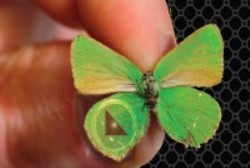Sep 2 2013
By mimicking microscopic structures in the wings of a butterfly, an international research team has developed a device smaller than the width of a human hair that could make optical communication faster and more secure.

The researchers, from Swinburne University of Technology in Australia and Friedrich-Alexander Universität Erlangen-Nürnberg in Germany, have produced a photonic crystal that can split both left and right circularly polarised light.
The design for this crystal was inspired by the Callophrys Rubi butterfly, also known as the Green Hairstreak. This butterfly has 3D nano-structures within its wings which give them their vibrant green colour. Other insects also have nano-structures that provide colour, but the Callophrys Rubi has one important difference.
"This butterfly's wing contains an immense array of interconnected nano-scale coiled springs that form a unique optical material. We used this concept to develop our photonic crystal device," Swinburne PhD graduate, Dr Mark Turner, said.
Using 3D laser nano-technology, the Swinburne researchers built a photonic crystal with properties that don't exist in naturally occurring crystals, specifically one that works with circular polarisation. This miniature device contains over 750,000 tiny polymer nano-rods.
The photonic crystal acts as a miniature polarising beamsplitter, similar to a device invented by Scottish scientist William Nicol in 1828. Polarising beamsplitters used in modern technology - such as telecommunications, microscopy and multimedia - are built from naturally occurring crystals, which work for linearly polarised light but not circularly polarised light.
"We believe we have created the first nano-scale photonic crystal chiral beamsplitter," Director of the Centre for Micro-Photonics at Swinburne, Professor Min Gu, said.
"It has the potential to become a useful component for developing integrated photonic circuits that play an important role in optical communications, imaging, computing and sensing.
"The technology offers new possibilities for steering light in nano-photonic devices and takes us a step closer towards developing optical chips that could overcome the bandwidth bottleneck for ultra-high speed optical networks."
The research has been published in the journal Nature Photonics.
The researchers involved were Mark Turner, Qiming Zhang, Benjamin Cumming and Min Gu (Swinburne University of Technology) and Matthias Saba and Gerd E Schröder-Turk (Friedrich-Alexander Universität Erlangen-Nürnberg).
Dr Turner is now working in California's Silicon Valley to develop and commercialise new photonic technologies for real world applications.
This project is part of the Centre for Excellence for Ultrahigh-bandwidth Devices for Optical Systems (CUDOS), funded by the Australian Research Council under the Centres of Excellence Program, with further support from seven constituent universities, and fifteen partner investigators. Dr Turner's PhD project was also partly supported by the Australian Cooperative Research Centre for Polymers.